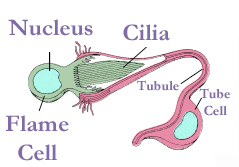
Flame cell
Encyclopedia

Invertebrate
An invertebrate is an animal without a backbone. The group includes 97% of all animal species – all animals except those in the chordate subphylum Vertebrata .Invertebrates form a paraphyletic group...
s, including flatworm
Flatworm
The flatworms, known in scientific literature as Platyhelminthes or Plathelminthes are a phylum of relatively simple bilaterian, unsegmented, soft-bodied invertebrate animals...
s (except the turbellarian order
Order (biology)
In scientific classification used in biology, the order is# a taxonomic rank used in the classification of organisms. Other well-known ranks are life, domain, kingdom, phylum, class, family, genus, and species, with order fitting in between class and family...
Acoela), rotifers and nemerteans
Nemertea
Nemertea is a phylum of invertebrate animals also known as "ribbon worms" or "proboscis worms". Alternative names for the phylum have included Nemertini, Nemertinea and Rhynchocoela. Although most are less than long, one specimen has been estimated at , which would make it the longest animal ever...
; these are the simplest animals to have a dedicated excretory system
Excretory system
The excretory system is a passive biological system that removes excess, unnecessary or dangerous materials from an organism, so as to help maintain homeostasis within the organism and prevent damage to the body. It is responsible for the elimination of the waste products of metabolism as well as...
. Flame cells function like a kidney
Kidney
The kidneys, organs with several functions, serve essential regulatory roles in most animals, including vertebrates and some invertebrates. They are essential in the urinary system and also serve homeostatic functions such as the regulation of electrolytes, maintenance of acid–base balance, and...
, removing waste materials. Bundles of flame cells are called protonephridia.
The flame cell has a nucleated cell body, with a "cup-shaped" projection, with cilia covering the inner surface of the cup. The beating of these cilia resemble a flame, giving the cell its name. The cup is attached to a tube cell, whose inner surface is also coated in cilia, which help to move liquid through the tube cell. The tube opens externally through a nephropore, or, in the trematoda
Trematoda
Trematoda is a class within the phylum Platyhelminthes that contains two groups of parasitic flatworms, commonly referred to as "flukes".-Taxonomy and biodiversity:...
, into an excretory bladder
Urinary bladder
The urinary bladder is the organ that collects urine excreted by the kidneys before disposal by urination. A hollow muscular, and distensible organ, the bladder sits on the pelvic floor...
. The function of these cells is to regulate the osmotic pressure
Osmotic pressure
Osmotic pressure is the pressure which needs to be applied to a solution to prevent the inward flow of water across a semipermeable membrane....
of the worm, and maintain its ionic balance. Microvilli in the tube cell may be used to reabsorb some ion
Ion
An ion is an atom or molecule in which the total number of electrons is not equal to the total number of protons, giving it a net positive or negative electrical charge. The name was given by physicist Michael Faraday for the substances that allow a current to pass between electrodes in a...
s.
See Also
- NephronNephronThe renal tubule is the portion of the nephron containing the tubular fluid filtered through the glomerulus. After passing through the renal tubule, the filtrate continues to the collecting duct system, which is not part of the nephron....
, the similar structure in vertebrates - Nephridia, the excretory organ in annelids
- Malphigian tubule system, the excretory organ in arthropods

